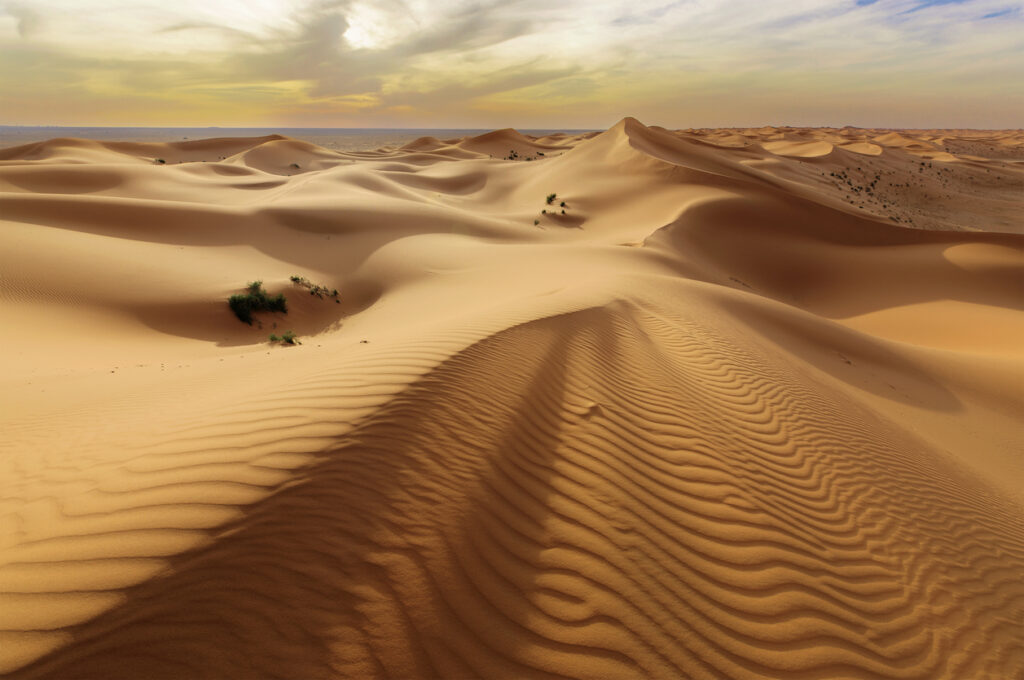
It’s hard to imagine Saudi Arabia’s endless dunes and scorching heat as anything but dry and desolate. But thousands of years ago, this same land was teeming with rivers, grasslands, and life. New research suggests that the Arabian Peninsula wasn’t always a harsh desert—it was once a lush, green environment that may have played a key role in early human migration.
That vision of ancient Arabia comes from recent studies of sediment layers, fossilised animals, and ancient lake beds hidden beneath the sand. Scientists are now piecing together a story that stretches back over 400,000 years, showing that this region experienced multiple wet periods, known as “Green Arabia” phases. During those times, it looked less like a barren landscape and more like the savannas of modern-day Africa.
Evidence is buried just beneath the sand.
In areas that now seem completely lifeless, researchers have uncovered signs of ancient lakes and river systems. Fossils of hippos, elephants, and even freshwater snails point to an ecosystem that could once support a wide range of animals—not to mention early humans. These wet periods didn’t last forever, but they kept returning every 20,000 years or so, triggered by shifts in the Earth’s orbit that pulled monsoon rains further north.
Each time Arabia turned green, it likely created a fertile bridge between Africa and Eurasia. This would have made it a critical route for early human migrations, offering food, water, and shelter in an otherwise unforgiving part of the world. These “climate windows” opened just long enough for our ancestors to move across the region and eventually settle further east.
Ancient tools offer more than just clues.
In places like Al Wusta and the Nefud Desert, archaeologists have discovered stone tools alongside fossilised remains and evidence of ancient lakes. These artefacts suggest that early humans didn’t just pass through the region. They lived there, adapted to the changing environment, and likely thrived during the greener phases.
These tools also help date the timing of human movement, lining up with known climate shifts. The idea that early humans only left Africa through narrow coastal paths is being replaced with a more complex picture—one where Arabia served as a central corridor that opened and closed with the climate.
It changes how we see deserts today.
When we think of deserts, we tend to picture lifelessness and permanence. But this research shows that deserts are far more dynamic than we assume. They can shift, breathe, and change over time, sometimes becoming fertile again, depending on global climate cycles. The Arabian Desert, it turns out, isn’t just a place of stillness; it’s a landscape with a surprisingly rich and active past.
This also reshapes how we view climate resilience. If ancient humans could adapt to the waxing and waning of Arabia’s wet and dry periods, it suggests that early populations were far more flexible than we often give them credit for. They followed the water, the vegetation, and the animals, ahaping their lives around a climate that kept evolving.
Why it matters today.
Understanding Arabia’s greener past isn’t just about ancient history. It’s about recognising how climate continues to influence where people can live, thrive, or struggle. As the world faces rising temperatures, regions like the Middle East are already grappling with water scarcity, heat stress, and environmental decline.
The contrast between Arabia’s lush past and its dry present also serves as a stark reminder of how quickly environments can shift. The fossils beneath the dunes are more than remnants—they’re warnings. They show us how sensitive ecosystems are to climate changes, and how important it is to protect the resources we still have.
It’s a land of extremes, shaped by water.
Saudi Arabia might be known today for its dry heat and dramatic dunes, but underneath that landscape lies a forgotten chapter—one full of rivers, grazing herds, and early human footprints. The transformation from green to golden sands didn’t happen overnight, but it left behind traces that are only now being uncovered.
And in those traces lies something strangely hopeful. If one of the world’s driest places was once a lush paradise, it means landscapes can change more than we expect. It’s not about turning back the clock, but about learning from the past to better understand the delicate balance between climate, life, and survival.